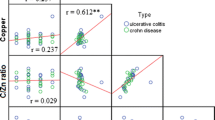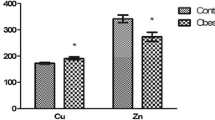Abstract
Serum Zn and Cu levels were measured by atomic absorption spectrophotometry in 117 children (aged 3 months to 5 years), divided into two groups; 80 children suffered from severe malnutrition and 37 children served as controls. Significantly lower levels of serum Zn and Cu were found in the malnutrition group. Zn levels of 2.59±0.15 µg/ml as compared to 3.92±0.35 µg/ml in the control group (P=0.0037) and Cu levels of 0.74±0.05 µg/ml in the malnutrition group as compared to 1.19±0.08 µg/ml in the control group were observed. Superoxide dismutase activity in children with severe malnutrition was 21.13±0.75 U/min per mg protein as compared to 26.02±0.66 U/min per mg protein in controls. Absence of breast-feeding, recurrent respiratory tract infection and diarrhoea correlated significantly with low serum Zn and Cu levels. Hypoproteinaemia and anaemia in malnourished children were also associated with a significant decline in both serum Zn and Cu levels. Conclusion:Serum trace element deficiency leading to depleted antioxidant protection may be a contributing factor to the pathophysiology of protein malnutrition and replacement of these elements in the management of this condition might be important.

Similar content being viewed by others
Abbreviations
- PEM :
-
protein energy malnutrition
- SOD :
-
superoxide dismutase
References
AOAC (1990) Official methods of analysis of the association of official analytical chemists, 15th edn, vol 1. Association of Analytical Chemists Inc., Virginia
Fechner A, Bohme C, Gromer S, Funk M, Schirmer R, Becker K (2001) Antioxidant status and nitric oxide in the malnutrition syndrome kwashiorkor. Pediatr Res 49: 237–243
Goldenberg RL (2003) The plausibility of micronutrient deficiency in relationship to perinatal infection. J Nutr 133: 1645S–1648S
Honkanen VEA, Lamberg-Allardt CH, Vestermen MK, Lehto JH, Westermark TW, Metsa-Ketala TK (1991) Plasma zinc and copper concentration in rheumatoid arthritis: influence of dietary factors and disease activity. Am J Clin Nutr 54: 1082–1086
Kakkar, P, Viswanathan PN (1992) Formation and scavenging of active oxygen species in immunological responses. J Sci Indus Res 51: 802–809
Kakkar P, Das B, Viswanathan PN (1984) A modified spectrophotometric assay of superoxide dismutase. Ind J Biochem Biophys 21: 130–132
Ojoteitimi EO, Owolabi OO, Aderonmu A, Esimai AO, Olasanmi SO (2003) A study on under five nutritional status and its determinants in semirural community of Ile-Ife, Osun State, Nigeria. Nutr Health 17: 21–27
Tatli MM, Vural H, Koc A, Koseci KM (2000) Altered antioxidant status and increased lipid peroxidation in marasmic children. Pediatr Int 42: 289–292
Author information
Authors and Affiliations
Corresponding author
Rights and permissions
About this article
Cite this article
Thakur, S., Gupta, N. & Kakkar, P. Serum copper and zinc concentrations and their relation to superoxide dismutase in severe malnutrition. Eur J Pediatr 163, 742–744 (2004). https://doi.org/10.1007/s00431-004-1517-7
Received:
Accepted:
Published:
Issue Date:
DOI: https://doi.org/10.1007/s00431-004-1517-7




